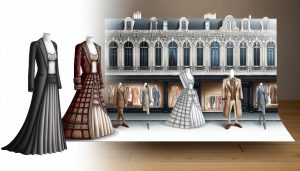As a fashion enthusiast, I’ve always been intrigued by the allure of designer brands. There’s something fascinating about the luxury, quality, and prestige that they offer. I’ve found that behind every iconic logo, there’s a rich history and a unique design philosophy that sets it apart. So, I’ve decided to delve deeper and explore the captivating world of designer brands. In this journey, I’ll be unraveling the evolution, economic impact, signature styles, and sustainability efforts of these high-end fashion labels.
Unveiling the Magic Behind Designer Brands
I’m fascinated by the allure and craftsmanship that makes such products so magical. I’ve observed how they effortlessly create a sense of luxury and exclusivity. I’ve seen how each intricately made piece becomes an emblem of status, a token of aspiration. I’ve felt the rush of owning one, the triumph of joining an elite club. I’ve marveled at their power to transform the ordinary into extraordinary, and the mundane into the magnificent.
The Evolution of Luxury Fashion Brands

It’s fascinating to see how luxury fashion brands have evolved over the years, constantly reinventing themselves to stay relevant and desirable. I’ve seen them adapt, innovate, and redefine what high-end fashion means in different eras. I’ve watched them respond to socio-cultural shifts, economic changes, and technological advancements with grace and agility. I’ve noticed that they’ve embraced sustainability, inclusivity, and digitalization in recent years. Yet, their commitment to craftsmanship, quality, and exclusivity remains unwavering.
Iconic Designer Brands and Their Signature Styles
In my opinion, Chanel’s timeless elegance and Gucci’s eclectic luxury are prime examples of iconic brands with signature styles. I’ve always admired the audacious creativity of Vivienne Westwood and the minimalist aesthetic of Jil Sander. It’s thrilling to see how Prada combines intellectualism with art in their designs. I can’t help but marvel at the innovation of Alexander McQueen, it’s avant-garde and at times, unsettling. Dior’s romanticism resonates with me, it’s like a love letter to femininity and I’m here for it.
The Economic Impact of High-End Fashion Labels
High-end fashion labels, believe it or not, have a significant economic impact that’s often overlooked. I’ve noted how these lavish labels contribute to job creation, tourism, and even local economies. I’m always amazed at how much revenue they generate annually, reaching into the billions. Never underestimate their power; they’re so much more than just the clothes we see on the runway. It’s a fascinating world, full of complexity and impact beyond the wardrobe.
Sustainability Efforts by Leading Designer Brands
As we delve deeper into the world of designer brands, it’s fascinating to see the significant shift towards sustainability. Leading designer brands aren’t just about opulence and aesthetics anymore, they’re consciously taking steps to reduce their carbon footprint. It’s a brave new world where luxury and responsibility coexist, paving the way for eco-friendly luxury fashion and unique green initiatives.
"Eco-Friendly Luxury Fashion"
Eco-friendly luxury fashion is something I’ve been closely following, and it’s truly inspiring to see how the industry is revolutionizing with sustainable practices. I’ve seen an admirable shift towards using recycled materials, sourcing from ethical suppliers, and creating less waste. It’s a conscious effort to create beautiful things with minimal harm to our planet. I’m excited about what the future holds for this movement. It’s clear that style doesn’t have to compromise sustainability.
"Designer Brands’ Green Initiatives"
I’m genuinely impressed by the green initiatives taken by these high-end fashion houses to promote sustainability. It’s not just a marketing gimmick, they’re actually making a difference. I’ve seen them use recycled materials, opt for eco-friendly packaging, and reduce energy consumption in their production processes. They’re setting a precedent, making it clear that caring for the environment doesn’t mean compromising on style or luxury. It’s refreshing and gives me hope for the future of fashion.
Frequently Asked Questions
How are designer brands different from regular fashion brands?
I’ve noticed that the main difference lies in quality and exclusivity. They’re often made from higher quality materials and have a more unique, distinct style compared to regular fashion brands.
What factors contribute to the high cost of designer brand items?
There are several factors that contribute to the high cost of these luxury items. It’s primarily due to the high-quality materials used, the intricate craftsmanship involved in production, and the brand’s reputation and marketing costs.
How have designer brands adapted to changes in the fashion industry over the years?
Over the years, I’ve observed that many high-end labels have adjusted to shifts in the fashion industry by incorporating technology and sustainability into their business models. They’ve also embraced diversity and inclusivity, creating pieces that cater to a wider range of consumers.
Conclusion
In conclusion, the world of designer brands is a dynamic and ever-evolving field, marked by exceptional craftsmanship, quality, and exclusivity. These brands have made significant strides in adapting to socio-cultural shifts, economic changes, and technological advancements. Iconic brands like Chanel, Gucci, and Alexander McQueen continue to influence global fashion trends and consumer behavior. Their economic impact is vast, contributing to job creation, tourism, and boosting local economies. Moreover, with their recent emphasis on sustainability, they are setting a precedent for the future of responsible and eco-friendly fashion.
